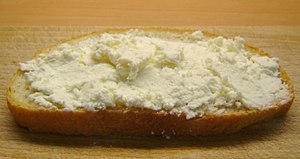This is an old revision of this page, as edited by Dpotop (talk | contribs) at 18:51, 16 January 2007 (moved Bryndza to Brânză: The word Bryndza does not exist in English. The article does not mention some other language in which the word exists as such. Therefore, I change its name to the Romanian word.). The present address (URL) is a permanent link to this revision, which may differ significantly from the current revision.
Revision as of 18:51, 16 January 2007 by Dpotop (talk | contribs) (moved Bryndza to Brânză: The word Bryndza does not exist in English. The article does not mention some other language in which the word exists as such. Therefore, I change its name to the Romanian word.)(diff) ← Previous revision | Latest revision (diff) | Newer revision → (diff)

Bryndza is a sheep's milk cheese made in the Balkans, Eastern Austria, Hungary, Poland, Romania, Russia, Slovakia, and Ukraine. Bryndza originated in Romania and thus its name is derived from the Romanian word for cheese: brânză. It probably came to Slovakia in the course of the settling of northern Slovakia by the Vlachs from the 14th century to the 17th century. The first written mention of bryndza in Slovakia appeared in the late 15th century. After improving the traditional method of bryndza production, a Slovak merchant Ján Vagač founded the first manufactory in 1787, in Detva. His new, longer-storable kind of bryndza began to spread to neighbouring regions afterwards. Vagač's method also distinguishes Slovak bryndza from its counterparts in other countries.
The process for making bryndza is similar to that for making quark. The sheep's milk is strained through linen into small wooden casks named burduf or putera. The putera are often made from spruce or fir wood. The temperature of the milk is raised to 30-35°C before further processing takes place. After numerous stages of processing, a cheese paste is produced. This is shaped and then left to lie for 5 to 6 days. During that time, in order to prevent mould and to ensure that the cheese matures equally, the cheese is regularly turned and wiped. After six days, a thin crust develops. This is removed and the cheese is melted and salt is added to it. This fine melted salt cheese is the finished bryndza. In some regions, onion or chives are added to the plain cheese.
After the process, the cheese contains roughly 40-50% of fat, 50-55% of water and 2-3% of salt. Like similar soft cheeses, bryndza does not keep well. Lovers of the cheese especially enjoy it when it has matured. Bryndza made purely of sheep's milk (such as the so-called Liptovská bryndza) is only produced and sold during a few months of the year. However, some producers mix stored sheep's cheese paste with fresh cow's cheese to prepare the so-called "winter bryndza".
Bryndza is an essential ingredient for Liptauer and for bryndzové halušky, which is a Slovak national dish. A similar sheep's milk cheese is used in Romania as a gratin for maccaroni (macaroane cu brânză) and polenta (mămăligă cu brînză) and many other dishes.
References
- This article incorporates text translated from the corresponding article from the German Misplaced Pages, retrieved on May 3, 2005.